In questi giorni sono venuto in possesso di un Adafruit NFC shield per arduino da utilizzare per un progetto su commissione ed ho eseguito qualche test prima di impegnarla in un progetto complesso.
L’Adafruit NFC è una shield basata sul PN532 in grado di leggere sia i tag di tipo NFC sia RFID a 13.56MHz.
In passato hai letto dei miei test con una shield simile della DF Robot: NFC Arduino in cui avevo testato la mia shield NFC prodotta dalla DF Robot.
Come funziona l’Adafruit NFC
L’adafruit NFC shield comunica con arduino mediante il protocollo I2C come scritto sul sito del produttore: I2C 7-bit address 0x48 ossia usa l’indirizzo 0x48 i2C e la shield é completamente compatibile con l’arduino uno attraverso il classico montaggio a castello.
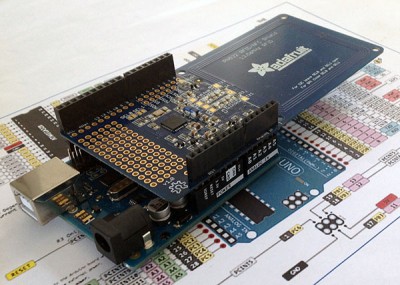
La shield è pre-assemblata al 90% mancano i solo header che vengono forniti come semplici pin maschi e che puoi sostituire con i classici header passanti a cui sei abituato per le altre shield.
Le istruzioni di montaggio le puoi trovare in questo link.

Se desideri approfondire il funzionamento dei tag NFC puoi leggere questa pagina presente sul sito adafruit stesso.
Ho provato la shield adafruit nfc con una tessera ATM ( Azienda Trasporti Milanesi ) di quelle anonime che puoi acquistare e ricaricare presso le edicole:
per la lettura ho usato uno degli sketch di esempio forniti dall’adafruit con la libreria per il controllo dell’PN532.
Sketch di test
Lo sketch che ho utilizzato per il test è il “readMifare” che ti riporto:
/**************************************************************************/
/*!
@file readMifare.pde
@author Adafruit Industries
@license BSD (see license.txt)
This example will wait for any ISO14443A card or tag, and
depending on the size of the UID will attempt to read from it.
If the card has a 4-byte UID it is probably a Mifare
Classic card, and the following steps are taken:
- Authenticate block 4 (the first block of Sector 1) using
the default KEYA of 0XFF 0XFF 0XFF 0XFF 0XFF 0XFF
- If authentication succeeds, we can then read any of the
4 blocks in that sector (though only block 4 is read here)
If the card has a 7-byte UID it is probably a Mifare
Ultralight card, and the 4 byte pages can be read directly.
Page 4 is read by default since this is the first 'general-
purpose' page on the tags.
This is an example sketch for the Adafruit PN532 NFC/RFID
breakout boards
This library works with the Adafruit NFC breakout
----> https://www.adafruit.com/products/364
Check out the links above for our tutorials and wiring diagrams
These chips use I2C to communicate
Adafruit invests time and resources providing this open source code,
please support Adafruit and open-source hardware by purchasing
products from Adafruit!
*/
/**************************************************************************/
#include <Wire.h>
#include <Adafruit_NFCShield_I2C.h>
#define IRQ (2)
#define RESET (3) // Not connected by default on the NFC Shield
Adafruit_NFCShield_I2C nfc(IRQ, RESET);
void setup(void) {
Serial.begin(115200);
Serial.println("Hello!");
nfc.begin();
uint32_t versiondata = nfc.getFirmwareVersion();
if (! versiondata) {
Serial.print("Didn't find PN53x board");
while (1); // halt
}
// Got ok data, print it out!
Serial.print("Found chip PN5");
Serial.println((versiondata>>24) & 0xFF, HEX);
Serial.print("Firmware ver. ");
Serial.print((versiondata>>16) & 0xFF, DEC);
Serial.print('.'); Serial.println((versiondata>>8) & 0xFF, DEC);
// configure board to read RFID tags
nfc.SAMConfig();
Serial.println("Waiting for an ISO14443A Card ...");
}
void loop(void) {
uint8_t success;
uint8_t uid[] = { 0, 0, 0, 0, 0, 0, 0 }; // Buffer to store the
// returned UID
uint8_t uidLength; // Length of the UID
// (4 or 7 bytes depending
// on ISO14443A card type)
// Wait for an ISO14443A type cards (Mifare, etc.). When one is found
// 'uid' will be populated with the UID, and uidLength will indicate
// if the uid is 4 bytes (Mifare Classic) or 7 bytes (Mifare Ultralight)
success=nfc.readPassiveTargetID(PN532_MIFARE_ISO14443A,uid,&uidLength);
if (success) {
// Display some basic information about the card
Serial.println("Found an ISO14443A card");
Serial.print(" UID Length: ");
Serial.print(uidLength, DEC);
Serial.println(" bytes");
Serial.print(" UID Value: ");
nfc.PrintHex(uid, uidLength);
Serial.println("");
if (uidLength == 4)
{
// We probably have a Mifare Classic card ...
Serial.println("Seems to be a Mifare Classic card (4 byte UID)");
// Now we need to try to authenticate it for read/write access
// Try with the factory default KeyA: 0xFF 0xFF 0xFF 0xFF 0xFF 0xFF
Serial.print("Trying to authenticate block 4");
Serial.println(" with default KEYA value");
uint8_t keya[6] = { 0xFF, 0xFF, 0xFF, 0xFF, 0xFF, 0xFF };
// Start with block 4 (the first block of sector 1) since sector 0
// contains the manufacturer data and it's probably better just
// to leave it alone unless you know what you're doing
success=nfc.mifareclassic_AuthenticateBlock(uid,uidLength,4,0,keya);
if (success)
{
Serial.println("Sector 1 (Blocks 4..7) has been authenticated");
uint8_t data[16];
// If you want to write something to block 4 to test with, uncomment
// the following line and this text should be read back in a minute
// memcpy(data, (const uint8_t[]){ 'a', 'd', 'a', 'f', 'r', 'u',
// 'i', 't', '.', 'c', 'o', 'm', 0, 0, 0, 0 }, sizeof data);
// success = nfc.mifareclassic_WriteDataBlock (4, data);
// Try to read the contents of block 4
success = nfc.mifareclassic_ReadDataBlock(4, data);
if (success)
{
// Data seems to have been read ... spit it out
Serial.println("Reading Block 4:");
nfc.PrintHexChar(data, 16);
Serial.println("");
// Wait a bit before reading the card again
delay(1000);
}
else
{
Serial.print("Ooops ... unable to read the requested block.");
Serial.println(" Try another key?");
}
}
else
{
Serial.println("Ooops ... authentication failed: Try another key?");
}
}
if (uidLength == 7)
{
// We probably have a Mifare Ultralight card ...
Serial.println("Seems to be a Mifare Ultralight tag (7 byte UID)");
// Try to read the first general-purpose user page (#4)
Serial.println("Reading page 4");
uint8_t data[32];
success = nfc.mifareultralight_ReadPage (4, data);
if (success)
{
// Data seems to have been read ... spit it out
nfc.PrintHexChar(data, 4);
Serial.println("");
// Wait a bit before reading the card again
delay(1000);
}
else
{
Serial.println("Ooops ... unable to read the requested page!?");
}
}
}
}
non entro nel dettagli della descrizione in quanto il codice è semplice e ben commentato e la documentazione fornita dalla adafruit è alquanto soddisfacente, tuttavia se ti occorrono delle delucidazioni su questo sketch puoi usare i commenti per chiedermele e proverò a rispondere alle domande.
Il risultato sul mio monitor seriale è stato il seguente:
l’adafruit nfc è riuscita a riconoscere la tessera ATM che gli ho avvicinato ma non è riuscita ad eseguire l’autenticazione in quanto il codice prova ad autenticarsi con la sequenza di byte standard per le Mifare non protette ed ovviamente la tessera che ho utilizzato non usa un codice di accesso standard.
Questa l’adafruit nfc accesa e pronta alla lettura dei tag nfc che vorrai testare:
Buon divertimento

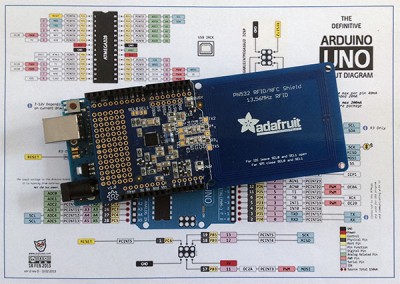
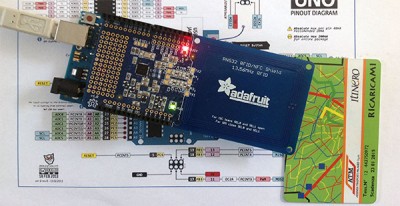
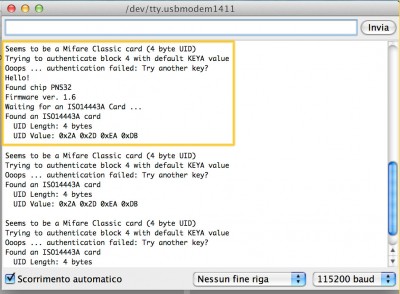
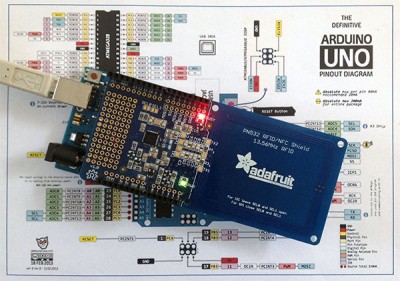


 Il blog mauroalfieri.it ed i suoi contenuti sono distribuiti con Licenza
Il blog mauroalfieri.it ed i suoi contenuti sono distribuiti con Licenza
14 commenti
Vai al modulo dei commenti
Buon giorno, sono uno studente di informatica e a breve avrò gli esami di stato.
Per l’orale ho pensato ad un registro elettronico in PHP correlato ad un supporto NFC fatto con l’Arduino, che prevede l’accesso senza l’inserimento delle credenziali se il tag é del professore e la registrazione dell’entrata e dell’uscita se il tag é dello studente.
La parte relativa alla gestione del “mondo didattico” ormai é completa. In questo momento sto solamente aspettando che arrivino gli ultimi componenti per costruire il supporto, ma mi é venuto un dubbio.
É possibile riconoscere una persona tramite l’antenna NFC del telefono invece che da un tag?
Grazie mille, spero possa rispondere in maniera tempestiva
Autore
Ciao Andrea,
so che alcuni telefoni hanno la funzione che ti occorre, purtroppo io non ne possiedo uno con tale caratteristica.
So che è possibile inserire sul database un valore preso con l’NFC tramite una pagina PHP adibita all’occorrenza. Ma è possibile aprire un indirizzo internet sul browser del computer, tramite l’aduino?
Autore
Ciao Andrea,
non ho compreso la domanda.
Per inserirli nel database non é un problema. Il problema mio é volere aprire, tramite un tag NFC, un indirizzo web nel browser del computer.
Autore
Ciao Andrea,
provo ad interpretare, non mi è del tutto chiaro: tu vuoi che all’avvicinarsi di un tag NFC al tuo lettore questo comunichi al computer di aprire una determinata pagina web nel browser ?
Esistono molti modi di farlo, ma il primo tra tutti è comprendere come ha scelto di far comunicare il lettore ed il computer, in seriale?
Certamente, ha capito benissimo. Si, la scheda è connessa all’arduino che a sua volta è connesso al computer tramite porta Seriale
Autore
Ciao Andrea,
bene allora devi scrivere un software che attenda un’informazione sulla seriale e apra il browser alla pagina che desideri quando riconosce il tag NFC che stai usando.
Ciao, è possibile collegare più shield Adafruit NFC ad un unicum Arduino contemporaneamente così che una legga un tag NFC mentre un’altra possa leggerne un altro? Grazie
Autore
Ciao Gianluca,
immagino sia possibile apportando delle modifiche hw alla shield per cambiarne l’indirizzo, usando due shield con differente indirizzo.
Poi dovrai modificarti la libreria per la comunicazione in modo che sia in grado di comunicare con entrambe.
vorrei sapere se con tale shield fosse possibile leggete questi semplici tag: [link rimosso in automatico]
Autore
Ciao Luca,
in primo luogo ti chiedo la cortesia di rispettare le regole del blog, le trovi scritte in fondo ad ogni articolo.
Nel testo ho riportato alcune delle specifiche dei tag leggibili e le altre puoi trovarle sul sito del produttore.
Se le informazioni sui tag stessi non ti fossero sufficienti puoi scrivere al venditore chiedendo di darti maggiori info come la Frequenza o il tipo di tag in modo da confrontarlo con le specifiche che possiedi.
Ciao Mauro,
forse il mio post è un po OT, ma magari mi puoi aiutare..
sto impazzendo con un PN532 NFC RFID module V3. Collegandolo ad arduino e utilizzando i programmi di esempio contenuti all’interno delle libreria, facendo le modifiche del caso al codice come indicato negli esempi, il modulo si accende ma non viene riconosciuto da arduino.
Potrebbe essere il modulo che non funziona?
Ti ringrazio per l’attenzione.
Autore
Ciao Mauro,
non ho provato molti moduli NFC ma tutti hanno funzionato sempre in modo egregio.
Hai verificato che l’indirizzo I2C sia lo stesso previsto dalla libreria ? Io ho scritto un articolo su come trovare l’indirizzo I2C di tali periferiche.